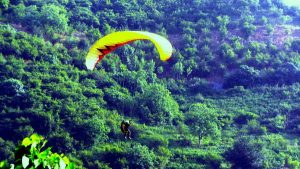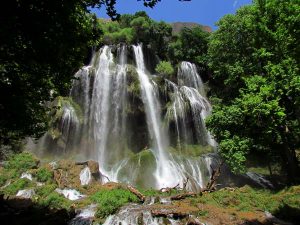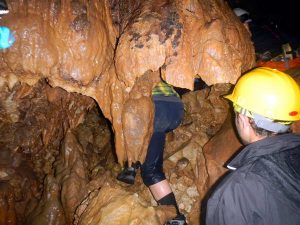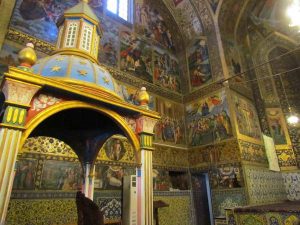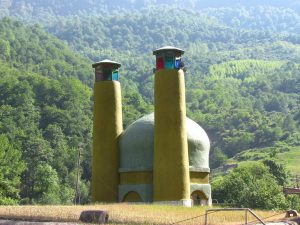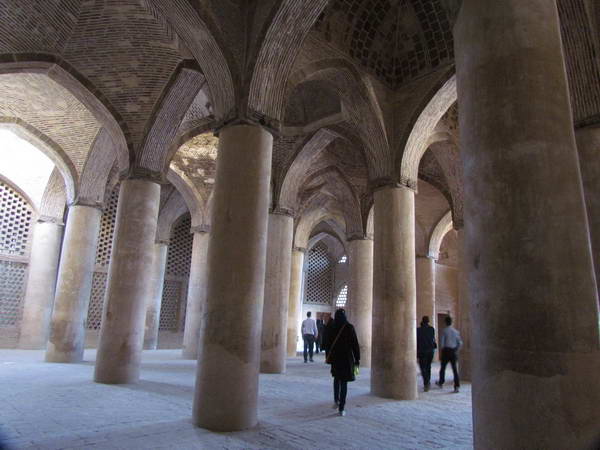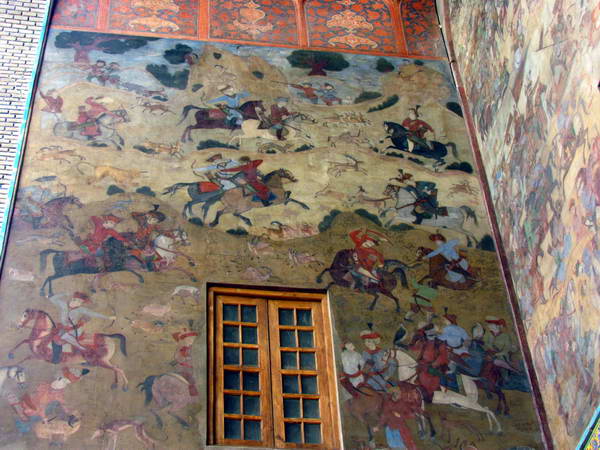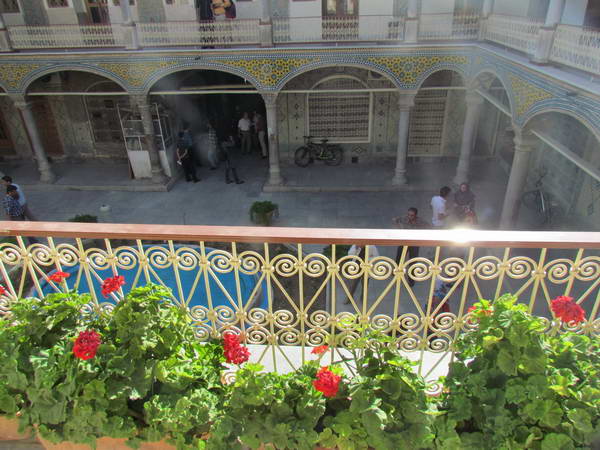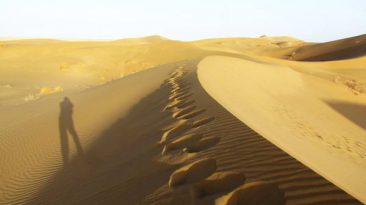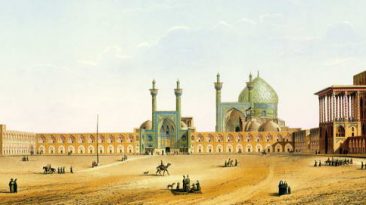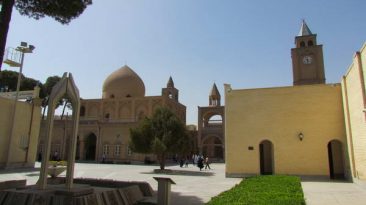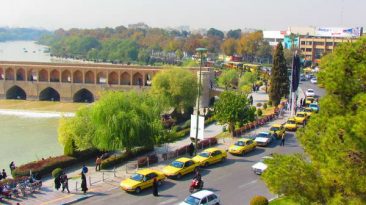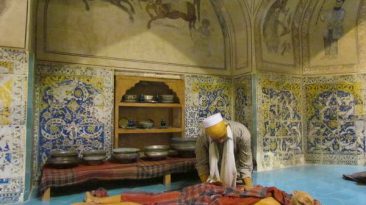We dedicate our second tour in Isfahan to visiting Isfahan Bazaar and the historical elements along the way of this bazaar. In this tour, in addition to Isfahan Grand Bazaar, we will visit Qeysarie Gate, Timcheh Malek, Assarkhaneh Shahi and Jameh Mosque, and we will see some of Isfahan’s handicrafts.
Qeysarie Gate, with valuable paintings
Qeysarie Bazaar is a historical bazaar on the north side of Naghsh Jahan Square in Isfahan. The entrance gate of this bazaar, which is known as “ Qeysarie Gate”, was built at the beginning of the Safavid period and has paintings by Reza Abbasi, the artist of that time. These paintings are mainly images of the war of the Abbasid kings with the Ottoman forces. Unfortunately, many of these paintings have been destroyed
Google map link of Qeysarie Gate
Isfahan Grand Bazaar
Isfahan Bazaar generally refers to the markets in Isfahan around Naghsh Jahan Square, such as Mesgarha Bazar ( blacksmiths’ bazaar ), the Qeysarie bazaar, and Isfahan Grand Bazaar.
Isfahan Grand Bazaar continues from Naghsh Jahan Square to the Grand Mosque (Atiq Mosque). This traditional market was built 400 years ago during the Safavid period.
In the Isfahan Grand Bazaar, there were mosques, baths, religious seminaries and Timcheh and numerous houses ( Sara ), many of which are still standing. There are several crossroads along Isfahan Grand Bazaar.
In addition, a series of markets branch off from the main bazaar, such as the Haruniyeh market, the samovar market, Tofangsazha market, the Qalandar garden market, the goldsmith market, the hatter market, and Nim Avard market.
Among the Timchehs ( houses for business and traditional shops in Isfahan Grand Bazaar ), we can name Timcheh Malek, Mokhles House, Golshan House, Ardestaniha House, Khani House, Agha House, Paderakht Sokhteh House, Miresmail House, Talar House, Khansari House, Saraye Jarchi and Saraye Fakhr.
Among the schools of religious sciences in Isfahan’s Grand Bazaar, we can name the following: Kasegaran School, Haruniyeh, Nimavard, Jeddeh Bozorg, Jeddeh Kuchak, Mullah Abdullah School, Jarchi Bashi School and Sadr School.
The mosques of Isfahan Grand Bazaar can be named as follows: Khayyatha Mosque, Masjedno Mosque, Zulfiqar Mosque, Shishegari Mosque, Jarchi Mosque.
Google map link of Isfahan Grand Bazar
Isfahan Handicrafts
Isfahan Handicrafts : The handicrafts of each country are among the works of art of the people of that country that show the historical and cultural identity of those people.
Due to its vastness, Iran has many kinds of handicrafts in different cities and regions. An example of important and prominent handicrafts in Iran can be listed as follows:
Weaving carpets, kilims and zillows
Work on metal (coppersmith works)
Pottery and ceramics
Fine industries such as enameling, turquoise, inlay and glass
Work on fabrics such as tapestry, crochet and cashmere
Painting and gilding
Printing on textiles and leather industries
Rural handicrafts such as mat weaving and making felt
Mosaic and wood inlay
Tiling
Assarkhaneh Shahi Museum, Isfahan
The 400-year-old Assarkhaneh Shahi, belonging to Safavid period, is located in Isfahan Bazaar.
Assarkhaneh is a place where oil has traditionally been extracted from oilseeds, such as sesame and cottonseed. This was done by grinding the grains with millstones and then squeezing the milled grains to get the oil out of them. The stones of the mill were moved by camels, and the pressing of the milled grains was done by the weight of beams from very large and long trunks of trees.
By entering the Assarkhane Shahi, you enter the space of e few hundred years ago. Here is a large but relatively dark hall with mud walls. The trunk of a very large and stout tree with a length of several meters and a diameter of more than one meter is based horizontally on beams. There are large millstones in the middle of the hall, which were moved by camels.
Oilseeds were first ground into flour. Then they made dough from them. The paste was then squeezed using a very heavy tree trunk to extract their oil. The oil was then collected in vats.
There were several Assarkhane mansions in Isfahan. The huge trees needed for them were imported from India, and they often had to demolish a number of houses along the way to get them inside the assarkhaneh.
Assarkhaneh Shahi is apparently related to the Safavid period . It have been active even until recently, when oil extracting machines had not yet entered the country. Even they have used motors and gearboxes to raise and lower the tree trunk.
Assarkhaneh Shahi has become a place for tourists to visit and it has been named “Assarkhanh Shahi Museum”.
There is another assarkhaneh called Jamaleh near the Isfahan Grand Mosque.
Google map link of Assarkhaneh Shahi Museum
Timche Malek ( Malekotojar ), In Historical Grand Bazar of Isfahan
Timcheh Malek Isfahan is one of the most beautiful old commercial complexes in the Grand Bazaar of Isfahan.
“Timcheh” or “Sara” refers to the old commercial complexes (passage) in the bazaar. In the historical bazaar of Isfahan, there are many of these Sara or Timchehs.
Timcheh Malek Isfahan is one of the most beautiful old commercial complexes in the bazaar, which was built during the Qajar period. This house includes a roofed mansion and a beautiful courtyard. Two-story rooms are built around the courtyard, which are the place of business for merchants and traders. The roofed mansion of this Timcheh has dome-shaped roofs with beautiful Mogharnas decorations.
Google map link of Timche Malek
Jameh Mosque of Isfahan, The oldest Islamic mansion in Isfahan
Jameh Mosque of Isfahan (Masjed Jameh or Grand Mosque of Isfahan) is a historical tourist attraction in Isfahan that quenches the thirst of those interested in visiting historical monuments. Jameh Mosque is a pre-Islamic historical complex that Over time, during the various post-Islamic regimes, parts have been added to this collection or even parts have been covered with new works.
The original construction of the Isfahan Grand Mosque dates back to the second century AH. This mosque was built in 156 AH / 777 AD. In 226 AH / 846 AD, by the order of Caliph Mutasim Abbasi, the former mosque was destroyed and a columned building was built with a wooden roof, of which part of the columns and walls still remain. But the most important changes in the mosque took place during the Seljuk period; The architects of this period distanced themselves from the pattern of the “Arab Mosque” and by building four porches on the north, south, east and west sides, created a new style which became known as the “Iranian Mosque”.
In 515 AH, this mosque was set on fire by the Ismailis, which was rebuilt in later periods. In the following centuries and in the Ilkhans, Mozaffari, Timurid, Safavid and Qajar periods, this mosque has undergone significant changes.
The location of Jameh Mosque is next to Imam Ali Square on Hatef Street. Isfahan Grand Bazaar is located between Jameh Mosque and Naghshe Jahan Square and connects the two.
Google map link of Jameh Mosque of Isfahan

